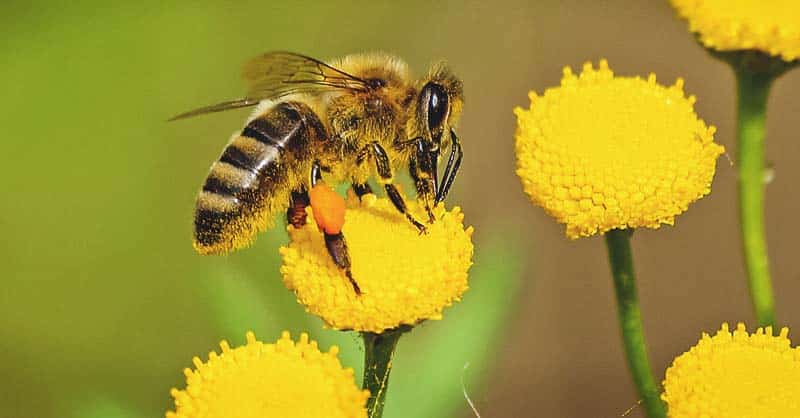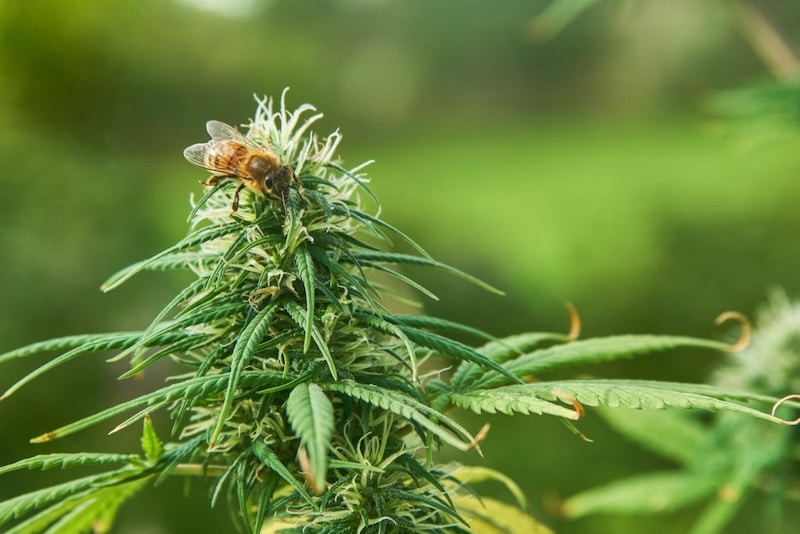Content:
- What is Pollination?
- Types of Pollination
- Methods of Pollination
- Pollination in Agriculture
- Environmental Impact of Pollination
- Economic Impact of Pollination
- Are Pollinators in Trouble?
- How to Help Pollinators
- FAQS
What is Pollination?
The importance of pollination in the maintenance of a healthy planet can not be understated. More than 80% of the world’s flowering plants need a pollinator to reproduce; and we need pollinators too, since most of our food comes from those flowering plants. We champion the bees as the world’s best pollinators, but what exactly is pollination? Are there different types? How many different kinds of pollinators are there? We’ll cover all these questions and more; let’s dive in.
Pollination, as defined by the USDA, is the act of transferring pollen grains from the male stamen of a flower to the female pistil. Essentially, pollination starts the production of seeds – the final part of the plant reproduction process. The production of seeds requires both the male and female parts of a plant.
The fertilization of a seed, from start to finish, goes like this:
- The anther, located at the tip of the stamen, produces pollen, which contains the male gametes (reproductive cells).
- The pollen is then carried to the female pistil by a pollination vector (wind, insect, bird, etc).
- Once the pollen gets to the part of the pistil called the stigma, it will germinate and grow a tiny tube down to the ovary.
- This pollen tube carries a male gamete to meet a female gamete in an ovule.
- The male gamete fertilizes the ovule and it develops into an embryo, which is stored in a capsule. We call that final form, the capsule containing the embryo, a seed.
For different plant species, the distance pollen travels can be as short as one part of the same flower to another part, or as far as it takes to travel to a different individual plant entirely. Plants that produce flowers that contain both male and female parts are known as hermaphroditic plants, also known as bisexual or perfect flowers. Plants that contain the male and female parts on separate flowers on the same individual plant, such as corn, cucumbers, and pine trees, are called monoecious plants. Finally, plants that house their male and female parts on separate individual plants, such as holly trees, asparagus, and persimmons, are called dioecious plants.
Types of Pollination
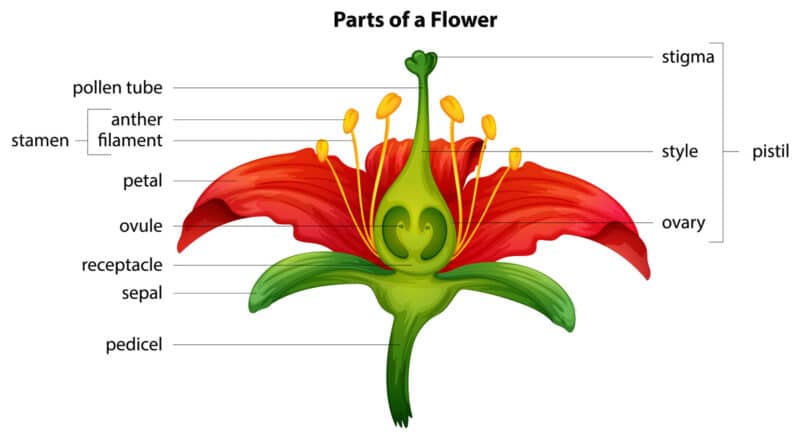
The aforementioned differences play an important role in determining whether a plant undergoes self-pollination or cross-pollination. Self-pollination is when the pollen from the anther is deposited on the stigma of the same flower or another flower on the same individual plant. Cross-pollination is the transfer of pollen from the anther of one flower to the stigma of another flower on a different individual plant of the same species.
Generally speaking, cross-pollination yields healthier plants. It decreases the risks associated with inbreeding and increases genetic variation. Cross-pollination allows for the formation of varieties, which can create stronger, more resilient, adaptable strains.
Dioecious plants only undergo cross-pollination. However, because their male and female plants need similar environments and resources to survive, they would compete with each other if they are too close together. Many dioecious plants rely on wind pollination for this reason, but this creates a new problem – they need to make a lot of pollen to increase the chances that their pollen will reach the distant female plant. As a result, dioecious plants expend a lot more energy than hermaphroditic and monoecious plants.
With self-pollination, on the other hand, the plant does not need to expend the energy needed to attract pollinators or produce lots of pollen, and it is not dependent on external pollination vectors. However, many hermaphrodite and monoecious plants have developed mechanisms to avoid self-pollination, or at the very least, undergo both cross and self-pollination, to maintain genetic diversity.
Methods of Pollination
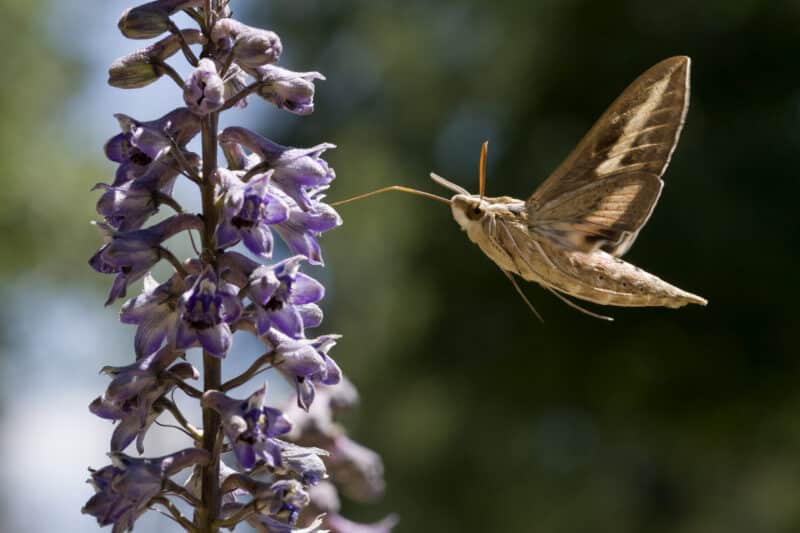
Unless a plant is solely reliant on self-pollination, it will require pollination vectors to transport its pollen. These pollination vectors can include wind, water, birds, insects, bats, or other animals that visit flowers. We call animals or insects that transfer pollen “pollinators.”
Usually, pollinators visit flowers in search of food, mates, shelter, or nest-building materials; the pollination is an unintended side effect. When a pollinator visits a flower to eat or collect pollen for its protein, sip on its sugary nectar, or take refuge in its petals, pollen grains will attach themselves to the animal’s body. When the animal visits another flower, the pollen can fall off and result in the successful fertilization of new offspring.
Animal pollinators include:
- Ants
- Flowers that are visited by ants are typically low growing, with small, inconspicuous flowers that grow close to the stem.
- Bats
- Flowers that are visited by bats are typically open at night, large in size (one to four inches), pale or white in color, and very fragrant. Over 300 species of fruit, including mangoes, bananas, and guavas, depend on bats for pollination!
- Bees
- Bees are the champion pollinators! In the US, there are over 4,000 species of native bees. Flowers visited by bees are typically brightly colored, open in the daytime, full of nectar, sweetly aromatic, and provide a landing platform for the bee.
- Beetles
- Beetles were among the first insects to visit flowers! As such, they are especially important pollinators for ancient species such as magnolias, ginkgos, and the spicebush. Beetles prefer flowers that have strong fruity, spicy, or sweet scents.
- Birds
- Birds are very important pollinators of wildflowers across the globe. The flowers that are visited by birds and hummingbirds usually have strong supports (for perching), are tubular with have petals that curve out of the way of the nectar source, and are brightly colored with little to no smell.
- Butterflies
- Butterflies are less efficient than bees at moving pollen between plants. The flowers they visit are usually brightly colored, bloom in clusters, and provide ample nectar as well as a landing platform for the butterfly.
- Flies
- Flies visit flowers with a putrid odor that range in color from pale and dull to dark brown or purple. Mosquitos fall under this category – yes, blood-sucking mosquitoes! They’re known pollinators of bog orchids.
- Moths
- Moths are attracted to nocturnal flowers with pale or white coloring, heavy fragrance and copious nectar, such as morning glory, tobacco, yucca, and gardenia.
- Wasps
- Wasps are important pollinators, and typically visit similar flowers to bees, with the notable exception of the fig wasp. Fig wasps are responsible for pollinating almost 1,000 species of figs!
Wind Pollination
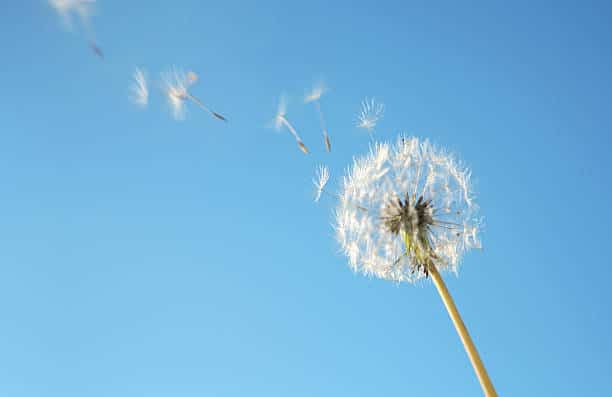
Wind-pollination is called anemophily. Plants that rely on wind for pollination don’t need to attract pollinators, so they are usually small, with no petals, special colors, odors, or nectar. They produce huge amounts of small pollen grains; for this reason, wind-pollinated plants tend to be allergens over animal-pollinated plants. The stigmas of anemophilous flowers may be large and feathery to better catch the airborne pollen grains as they float by.
Most conifer trees and about 12% of the world’s flowering plants are wind-pollinated, including many important crops, such as wheat, rice, rye, and barley. Nut-producing trees, such as walnuts, pecans, and pistachios, are usually wind-pollinated as well.
Water Pollination
Water-pollinated plants are, unsurprisingly, aquatic. Pollen floats on the water’s surface until it contacts flowers. This process is called hydrophily, but it is pretty rare (only 2% of pollination is hydrophily). Most aquatic plants are insect-pollinated, with flowers that bloom up into the air.
Pollination in Agriculture
Pollinators provide pollination services to over 180,000 different plant species and more than three-quarters of the staple crops that feed humanity. More than 150 crops in the US depend on pollination, including almost all fruit and grain crops. One out of every three bites of food that we eat is brought to us by pollinators.
Pollinators improve the quality and quantity of farmers’ crop yields. If a plant has been well pollinated, it will produce larger, tastier, and more uniform fruits. They are an essential part of a successful harvest; farmers will rent bees from beekeepers to help pollinate their crops. While there are other animal pollinators, bees are by far the most widespread and effective.
The honey bee is the most frequent single species of pollinator for crops worldwide. Pollination is the most critical factor in successful crop production, and because honey bees are easily managed and transported by humans, they have become a staple tool in agriculture across the globe.
While it’s easy to picture fruits and vegetables being products of pollination, we can’t forget about the more indirect products of equal importance. More than half of the world’s diet of fats and oils come from animal-pollinated plants like canola and sunflowers, and the meat industry relies upon pollination to ensure adequate food supplies for the animals.
Environmental Impact of Pollination

If a plant produces seeds, it requires pollination. Flowering plants form the biggest group of seed plants, with about 300,000 species around the world – that’s 90% of the whole plant kingdom. Almost all of these plants (80%) require pollination to reproduce. Pollination, therefore, is responsible for the ecosystem services these plants contribute to the environment, including carbon sequestration, water purification, biodiversity, and more.
Carbon Sequestration and Oxygen Production
Carbon dioxide is a heat trapping gas, produced both in nature by human activities. The buildup of carbon dioxide and other greenhouse gasses in the atmosphere traps heat and contributes to climate change. Flowering plants help to combat this greenhouse effect by utilizing the carbon dioxide in the atmosphere during photosynthesis; they take in the carbon dioxide and expel oxygen as a waste product of their metabolism.
Once they take in the CO2 and break apart the carbon and the oxygen, the carbon can be sequestered in the ground and stored as soil organic carbon, a measurable component of soil organic matter. Trees store carbon in their wood, and plants with large root systems, such as many prairie grass species, store it in their roots underground.
Without pollination and these plants, our atmosphere would not only rapidly heat up, but our oxygen levels would fall, with less plants to produce the oxygen we need to survive.
Water Purification and Water Cycle
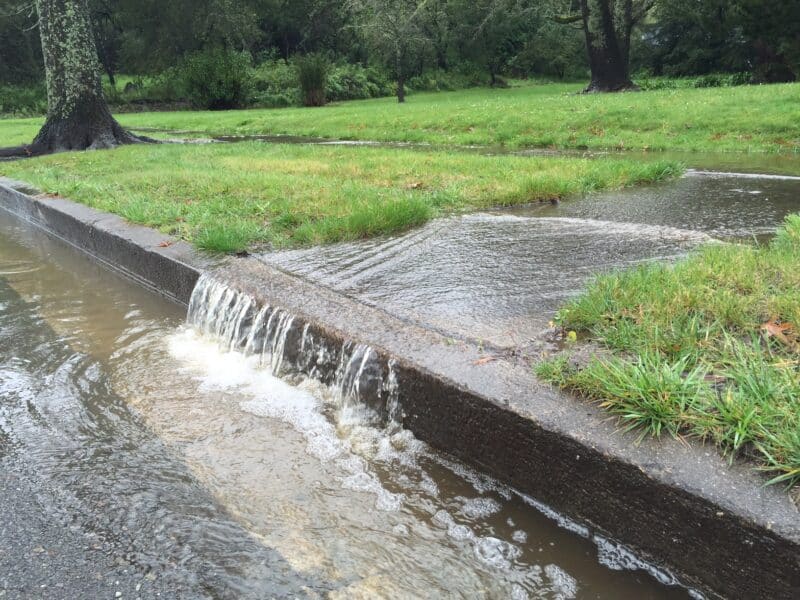
Pollination enables the growth of ground cover, which helps prevent runoff. Runoff picks up fertilizer, oil, pesticides, dirt, bacteria, and whatever else it comes into contact with as it travels to nearby creeks and streams. It’s a major source of water pollution, but plants lessen the chances runoff happening in the first place.
Plants’ roots improve the soil’s ability to soak up water, so runoff is absorbed and filtered by the soil before it can get to a water source. The very presence of plants slows the speed of the water moving over the land, which lowers the chances of flooding and erosion. Ground cover also prevents erosion by holding the soil in place; root systems help maintain the structural integrity of stream and river banks.
Plants also play an important role in the water cycle. Plant transpiration, the process in which plants return water from the soil back into the atmosphere, makes up about 10% of total moisture content in the atmosphere. Pollination, therefore, affects the local climate by contributing to cloud formation and amount of precipitation over the area through facilitating the growth of the plants.
Biodiversity
Biodiversity stimulates health, resilience, adaptability, and productivity of ecosystems. Without pollination, both the flora and fauna of our planet would look very different from what they are today.
There are plants that reproduce without pollination by means of asexual reproduction. Essentially, the offspring is a genetic clone of the parent plant. Many types of root plants, such as garlic, potatoes, and ginger, propagate themselves this way, as do ferns, liverworts, and mosses. But imagine if those plants were all we had – animals and insects that rely on non-asexual plants would go extinct, and the adaptability and resiliency of the Earth’s ecosystems would plummet.
Pollinators are also an important part of the food web. Insects, like moths and beetles, feed more than 80% of birds in the US, as well as reptiles, amphibians, and mammals. Also, pollination is what enables the continued existence of the vast majority of plants that make up the foundation of the food web. Without pollination, the entire food chain would crumble!
Economic Impact of Pollination

Pollinators as a whole contribute up to $577 billion annually in global food production; honey bees in the US alone contribute nearly $20 billion. If you factor in the medicines, biofuels, fibers, raw materials, and products bees and other pollinators provide, globally, pollination services are likely worth more than three trillion dollars.
Aside from food production, honey bees contribute to the economy through the commodification of honey, beeswax, propolis, and royal jelly. The global honey market value is expected to reach $13.6 billion by 2030, according to Grand View Research. In 2017, the US honey industry was responsible for more than 22,000 jobs.
Agriculture is steadily increasing its dependency on pollination services; the actual volume of agricultural production that relies on animal pollination has increased by 300% over the last 50 years. The honey bee pollination services are worth between $250 million and $320 million annually, according to the USDA’s Economic Research Service, and that value will only continue to grow as demand increases.
Many crops that are especially dependent on pollinators, such as cocoa, coffee, soybeans, palm oil, and avocados, are cash crops that many lower-income countries rely upon for trade. If the pollinator population were to dramatically decline, not only would we live in a world without chocolate and coffee, but it could pose a significant negative economic threat to some of the world’s poorest countries.
Are Pollinators in Trouble?
The combined effect of climate change, habitat loss, pathogen infestations, and pesticides still poses a serious threat to bee health and survival. After a decade of precipitous declines, the total number of honeybee colonies in the U.S. stabilized, and for the past five years, we’ve experienced only minor increases and decreases. By the end of 2019, there were 3.02 million honeybee colonies in the U.S. In April 2020, that number dropped to 2.98 million. These totals mask the ongoing battle to replace lost hives, which continues to be a big issue, with more than 40% of all honeybee colonies lost each year in the United States.
As more and more land is developed for agriculture, urban growth, and human dwellings, pollinator habitat and nutrition suffer. Bees and other pollinators need a variety of plants to attain a healthy diet – decorative lawns, sprawling parking lots, and agricultural monoculture do not supply that necessary variety. These developments also diminish the availability of suitable nesting sites for ground-dwelling pollinators.
Pollinators are also impacted by the unintended consequences of global trade: the introduction of non-native pests and pathogens. Varroa mites are especially dangerous for honey bees; they are one of the leading causes of death in beehives across the US.
Pesticides, herbicides, and insecticides are also a major threat to pollinators. These chemicals can directly impact the bees, either killing them outright or negatively affecting their cognitive behavior, fertility, or foraging ability. Herbicides also target weeds and wildflowers, which are sources of pollen and nectar for bees and other pollinators.
How to Help Pollinators

Help pollinators by taking small actions to combat the threats they face. Plant a garden where there once was an empty lawn and minimize your use of pesticides as you watch it grow. Use your power as a consumer to send a message and avoid buying food grown using pesticides. Support your local beekeepers by purchasing their honey. Learn more in our article “17 Ways You Can Help Save The Bees.”
Interested in utilizing scientifically-managed beehives to bring the vital process of pollination to your site? Click HERE to connect with one of our experts.
FAQ
Q: What is Pollination?
A: Pollination is the transference of pollen from the male reproductive organ of a plant to the female reproductive organ; it is the necessary starting point for plant reproduction.
Q: Why is Pollination Important?
A: Pollination has a vast economic impact; globally, pollination services are estimated to be valued at over three trillion dollars. Aside from the economic value, pollination sets the foundation of the food chain by facilitating the growth of plants, and animal pollinators themselves play an important role in food chain. Without pollination, Earth’s biodiversity would plummet, taking the health of our ecosystems down with it.
Q: What is a Pollinator?
A: An animal pollinator is any insect, bird, mammal, reptile, etc. that aids in the pollination process by carrying and dropping pollen. A natural pollinator, such as wind or water, are natural forces that play a transportation role in the pollination process.
Q: Do Wasps Pollinate?
A: Yes, wasps are pollinators! Find out more in our article “20 Types of Wasps and Hornets.”
Q: Are Carpenter Bees Pollinators?
A: Yes, carpenter bees are pollinators! Check out our article, “Everything You Need To Know About The Carpenter Bee” to learn more.


